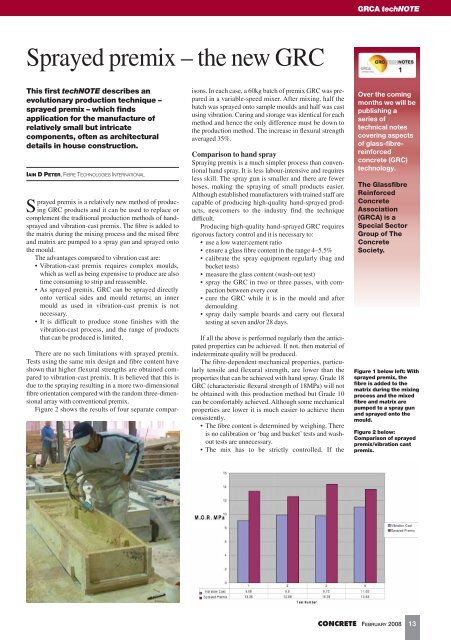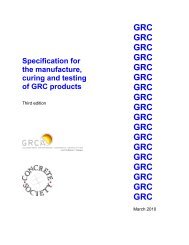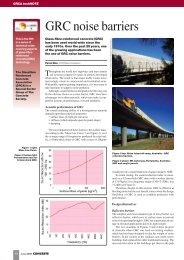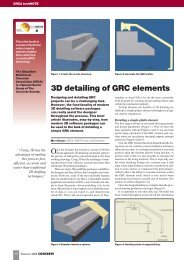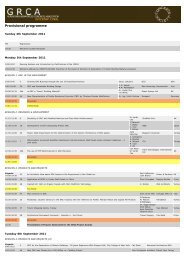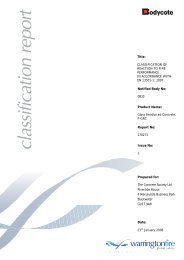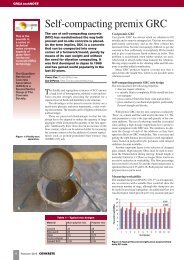Sprayed premix – the new GRC - The Concrete Society
Sprayed premix – the new GRC - The Concrete Society
Sprayed premix – the new GRC - The Concrete Society
Create successful ePaper yourself
Turn your PDF publications into a flip-book with our unique Google optimized e-Paper software.
<strong>GRC</strong>A techNOTE<br />
<strong>Sprayed</strong> <strong>premix</strong> <strong>–</strong> <strong>the</strong> <strong>new</strong> <strong>GRC</strong><br />
This first techNOTE describes an<br />
evolutionary production technique <strong>–</strong><br />
sprayed <strong>premix</strong> <strong>–</strong> which finds<br />
application for <strong>the</strong> manufacture of<br />
relatively small but intricate<br />
components, often as architectural<br />
details in house construction.<br />
IAIN D PETER, FIBRE TECHNOLOGIES INTERNATIONAL<br />
<strong>Sprayed</strong> <strong>premix</strong> is a relatively <strong>new</strong> method of producing<br />
<strong>GRC</strong> products and it can be used to replace or<br />
complement <strong>the</strong> traditional production methods of handsprayed<br />
and vibration-cast <strong>premix</strong>. <strong>The</strong> fibre is added to<br />
<strong>the</strong> matrix during <strong>the</strong> mixing process and <strong>the</strong> mixed fibre<br />
and matrix are pumped to a spray gun and sprayed onto<br />
<strong>the</strong> mould.<br />
<strong>The</strong> advantages compared to vibration cast are:<br />
• Vibration-cast <strong>premix</strong> requires complex moulds,<br />
which as well as being expensive to produce are also<br />
time consuming to strip and reassemble.<br />
• As sprayed <strong>premix</strong>, <strong>GRC</strong> can be sprayed directly<br />
onto vertical sides and mould returns; an inner<br />
mould as used in vibration-cast <strong>premix</strong> is not<br />
necessary.<br />
• It is difficult to produce stone finishes with <strong>the</strong><br />
vibration-cast process, and <strong>the</strong> range of products<br />
that can be produced is limited.<br />
<strong>The</strong>re are no such limitations with sprayed <strong>premix</strong>.<br />
Tests using <strong>the</strong> same mix design and fibre content have<br />
shown that higher flexural strengths are obtained compared<br />
to vibration-cast <strong>premix</strong>. It is believed that this is<br />
due to <strong>the</strong> spraying resulting in a more two-dimensional<br />
fibre orientation compared with <strong>the</strong> random three-dimensional<br />
array with conventional <strong>premix</strong>.<br />
Figure 2 shows <strong>the</strong> results of four separate comparisons.<br />
In each case, a 60kg batch of <strong>premix</strong> <strong>GRC</strong> was prepared<br />
in a variable-speed mixer. After mixing, half <strong>the</strong><br />
batch was sprayed onto sample moulds and half was cast<br />
using vibration. Curing and storage was identical for each<br />
method and hence <strong>the</strong> only difference must be down to<br />
<strong>the</strong> production method. <strong>The</strong> increase in flexural strength<br />
averaged 35%.<br />
Comparison to hand spray<br />
Spraying <strong>premix</strong> is a much simpler process than conventional<br />
hand spray. It is less labour-intensive and requires<br />
less skill. <strong>The</strong> spray gun is smaller and <strong>the</strong>re are fewer<br />
hoses, making <strong>the</strong> spraying of small products easier.<br />
Although established manufacturers with trained staff are<br />
capable of producing high-quality hand-sprayed products,<br />
<strong>new</strong>comers to <strong>the</strong> industry find <strong>the</strong> technique<br />
difficult.<br />
Producing high-quality hand-sprayed <strong>GRC</strong> requires<br />
rigorous factory control and it is necessary to:<br />
• use a low water:cement ratio<br />
• ensure a glass fibre content in <strong>the</strong> range 4<strong>–</strong>5.5%<br />
• calibrate <strong>the</strong> spray equipment regularly (bag and<br />
bucket tests)<br />
• measure <strong>the</strong> glass content (wash-out test)<br />
• spray <strong>the</strong> <strong>GRC</strong> in two or three passes, with compaction<br />
between every coat<br />
• cure <strong>the</strong> <strong>GRC</strong> while it is in <strong>the</strong> mould and after<br />
demoulding<br />
• spray daily sample boards and carry out flexural<br />
testing at seven and/or 28 days.<br />
If all <strong>the</strong> above is performed regularly <strong>the</strong>n <strong>the</strong> anticipated<br />
properties can be achieved. If not, <strong>the</strong>n material of<br />
indeterminate quality will be produced.<br />
<strong>The</strong> fibre-dependent mechanical properties, particularly<br />
tensile and flexural strength, are lower than <strong>the</strong><br />
properties that can be achieved with hand spray. Grade 18<br />
<strong>GRC</strong> (characteristic flexural strength of 18MPa) will not<br />
be obtained with this production method but Grade 10<br />
can be comfortably achieved. Although some mechanical<br />
properties are lower it is much easier to achieve <strong>the</strong>m<br />
consistently.<br />
• <strong>The</strong> fibre content is determined by weighing. <strong>The</strong>re<br />
is no calibration or ‘bag and bucket’ tests and washout<br />
tests are unnecessary.<br />
• <strong>The</strong> mix has to be strictly controlled. If <strong>the</strong><br />
Over <strong>the</strong> coming<br />
months we will be<br />
publishing a<br />
series of<br />
technical notes<br />
covering aspects<br />
of glass-fibrereinforced<br />
concrete (<strong>GRC</strong>)<br />
technology.<br />
<strong>The</strong> Glassfibre<br />
Reinforced<br />
<strong>Concrete</strong><br />
Association<br />
(<strong>GRC</strong>A) is a<br />
Special Sector<br />
Group of <strong>The</strong><br />
<strong>Concrete</strong><br />
<strong>Society</strong>.<br />
Figure 1 below left: With<br />
sprayed <strong>premix</strong>, <strong>the</strong><br />
fibre is added to <strong>the</strong><br />
matrix during <strong>the</strong> mixing<br />
process and <strong>the</strong> mixed<br />
fibre and matrix are<br />
pumped to a spray gun<br />
and sprayed onto <strong>the</strong><br />
mould.<br />
Figure 2 below:<br />
Comparison of sprayed<br />
<strong>premix</strong>/vibration cast<br />
<strong>premix</strong>.<br />
CONCRETE FEBRUARY 2008 13
<strong>GRC</strong>A techNOTE<br />
Figure 3 top:<br />
Comparison of<br />
production methods.<br />
Figure 4 above: Ageing<br />
behaviour comparison.<br />
water:cement ratio is too high or too low <strong>the</strong>n spraying<br />
is difficult or impossible.<br />
• Compaction is used to ensure a good surface finish<br />
but it is not required to expel air or to ensure that <strong>the</strong><br />
fibre is encapsulated by <strong>the</strong> cement.<br />
• <strong>The</strong> sprayed material is homogeneous and unlike<br />
hand spray, over-sprayed material can be used, thus<br />
reducing wastage.<br />
• As <strong>the</strong> properties achieved are more consistent,<br />
fewer sample boards are required, which in turn<br />
reduces testing costs.<br />
• <strong>The</strong> equipment is much easier and quicker to clean<br />
and uses less water. As <strong>the</strong> moving parts of <strong>the</strong> pump<br />
do not come into contact with <strong>the</strong> mix <strong>the</strong>n it can be<br />
used for faster-setting materials.<br />
Aged properties<br />
<strong>The</strong> change in time with certain fibre-dependent properties<br />
is well understood and is allowed for in conservative<br />
design rules. With hand spray <strong>the</strong> decline can appear<br />
quite dramatic, although in <strong>the</strong> fully aged state <strong>the</strong>re<br />
remains a significant factor of safety.<br />
For sprayed <strong>premix</strong> with lower initial properties, <strong>the</strong><br />
decline is very small and <strong>the</strong> 28-day properties are very<br />
similar to <strong>the</strong> fully aged properties. In practice, this can<br />
mean that <strong>the</strong> potential for an in-service failure is<br />
removed.<br />
Essentials to produce a good-quality sprayed<br />
<strong>premix</strong><br />
In order to produce consistent high-quality sprayed <strong>premix</strong><br />
<strong>GRC</strong>, <strong>the</strong> following are required:<br />
High-quality raw materials<br />
It is particularly important that <strong>the</strong> alkali-resistant fibre<br />
should be formulated for use in <strong>premix</strong>; chopped handspray<br />
fibre is not suitable.<br />
Specific mix design<br />
A suitable mix design should be established and once<br />
determined must be used consistently.<br />
Controlled batching/weighing of materials<br />
In order to maintain consistency, controlled batching/<br />
weighing of raw materials is important. Dry materials can<br />
be used from weighed bags but <strong>the</strong> water, polymer and<br />
o<strong>the</strong>r liquid additives should be automatically batched<br />
and dispensed.<br />
Mixer designed for <strong>premix</strong> <strong>GRC</strong><br />
High shear mixing is required for producing <strong>the</strong><br />
sand/cement slurry but <strong>the</strong> fibre must be blended into <strong>the</strong><br />
mix at slower speed. A mixer specifically designed for<br />
<strong>premix</strong> <strong>GRC</strong> should be used.<br />
Premix spray station comprising pump and spray gun<br />
A peristaltic-type pump is required toge<strong>the</strong>r with a <strong>premix</strong><br />
spray gun.<br />
Concluding remarks<br />
<strong>Sprayed</strong> <strong>premix</strong> produces <strong>GRC</strong> with consistent properties<br />
(some mechanical properties are lower but <strong>the</strong>y are more<br />
stable) and <strong>the</strong> fibre content is guaranteed. <strong>The</strong> process is<br />
much simpler than traditional hand spray and is less<br />
labour-intensive. As labour costs increase, sprayed <strong>premix</strong><br />
will become increasingly popular.<br />
■<br />
■ Fur<strong>the</strong>r information:<br />
<strong>The</strong> technical note is a result of development work over a<br />
number of years and was presented in full at <strong>the</strong> last <strong>GRC</strong>A<br />
International Congress, <strong>GRC</strong> 2005, in Hong Kong. Readers<br />
may note that <strong>the</strong> next Congress of <strong>the</strong> <strong>GRC</strong>A, <strong>GRC</strong> 2008,<br />
takes place in Prague on 20<strong>–</strong>23 April 2008. Registration of<br />
delegates is welcomed: please contact:<br />
congress@concrete.org.uk to register, or info@grca.co.uk<br />
for fur<strong>the</strong>r information.<br />
14<br />
‘<br />
Tests using <strong>the</strong> same mix design and fibre content have shown<br />
that higher flexural strengths are obtained compared to<br />
vibration-cast <strong>premix</strong>.<br />
’<br />
FEBRUARY 2008 CONCRETE


